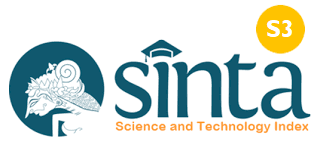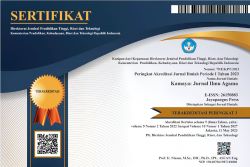Kebijakan Dinas Perhubungan Kota Palangkaraya Dalam Penertiban Juru Parkir Liar Perspektif Siyasah Syar’iyah
DOI:
https://doi.org/10.37329/kamaya.v8i3.4740Keywords:
Pengelolaan, Pengawasan, Retribusi parkirAbstract
The development and enforcement of parking regulations in Palangka Raya is an ongoing effort aimed at increasing local revenue. To prevent the rise in illegal parking violations, the Palangka Raya City Transportation Agency is taking enforcement action. This research was conducted in Palangka Raya City using the Normative legal research method and Empirical legal research, as well as a descriptive qualitative approach. The results of this study indicate that parking supervision in the city of Palangka Raya has been running although not optimally, parking supervision is carried out by forming a special team that will supervise, monitor and control in the field every day and involve other agencies. as well as creating new innovations by including a fast and accurate supervision system using the Si-Takir application (Parking Arrangement System) to improve parking management and accountability, as well as public complaint tools. The Retribution Management System Based on Palangka Raya Mayor Regulation No. 24 of 2022 in organizing parking on the side of public roads can be managed directly by the Palangka Raya City Regional Government and/or can collaborate with individuals and/or business entities. Before the cooperation of individuals or business entities, the Palangka Raya City Regional Government through the Palangka Raya City Transportation Agency conducts a parking potential survey and makes technical considerations. Obstacles that can hinder and support the Palangka Raya City Transportation Agency in implementing the regulation of illegal parking violations on the road are weak citizen participation in maintaining order, or resistance to changes related to the values of discipline and collective responsibility, reflection of social ethics, public policy without the support of the community's moral culture will be difficult to implement optimally. From a sharia perspective, illegal parking management can be seen as a government policy, implemented through the Palangka Raya City Transportation Agency, aimed at realizing public welfare and preventing harm. The government has a responsibility to regulate and regulate public spaces, including roads and parking facilities. Controlling illegal parking is part of this responsibility.
References
Abdurohim, D. (2020). Strategi Pengembangan Kelembagaan UMKM. Yogyakarta: Bintang Pustaka Madani.
Priambodo, A. W., Harsanto, P., & Adnan, M. (2013). Analisis Pengelolaan Parkir Tepi Jalan Umum di Kota Semarang Tahun 2012-2013. Journal of Politic and Government Studies, 3(1), 141-155.
Abubakkar Skandar. (2007). Menuju Lalu Lintas dan Angkutan Jalan yang Tertib. Jakarta: Departemen Perhubungan Indonesia.
Abdul Wahab, S. (2008). Pengantar Analisis Kebijakan Publik. Malang: Universitas Muhammadiyah Malang Press.
Agustino, L. (2012). Dasar Dasar Kebijakan Publik. Bandung: Alfabeta.
Andika, R. (2022). Aplikasi ‘Si Takir’ Bawa Palangka Raya Raih Penghargaan Inovasi Digital Nasional. Kalteng.antaranews.com.
Bhakti Satriya Perdana Sugiyanto & Gunarto. (2018). Peran Satlantas Polres Rembang dalam Menanggulangi Tingginya Kecelakaan Akibat Parkir Liar (Studi Kasus di Kabupaten Rembang). Jurnal Daulat Hukum, 1(1).
Bintoro Tjokroadidjojo & Djajai, M. (1980). Teori Strategi Pembangunan Nasional. Jakarta: Gunung Agung.
Dara Tasmania. (2022). Penertiban Parkir Liar di Lingkungan Kota Pekanbaru Berdasarkan Peraturan Walikota Pekanbaru Nomor 138 Tahun 2020 Tentang Penyelenggaraan Perparkiran (Skripsi). Universitas Lancang Kuning Pekanbaru.
Eri. (2021). Luncurkan Si Takir Urusan Parkir di Palangka Raya Bakal Naik Level. Beritakalteng.com.
Guna Nugraha, P. (2013). Studi tentang Peran Dinas Perhubungan dalam Menertibkan Parkir Liar di Pasar Pagi Kota Samarinda. Jurnal Administrasi Negara. Universitas Mulawarman.
Ibnu Syarif Mujar. (2008). Fiqih Siyasah: Doktrin dan Pemikiran Politik Islam. Jakarta: Erlangga.
Jonaedi Efendi & Ibrahim, J. (2018). Metode Penelitian Hukum Normatif dan Empiris. Depok: PrenadaMedia Group.
Ratnawati, N. L. T. T., & Subawa, N. S. (2021). Perubahan Perilaku Sosial Masyarakat Dalam Penertiban Pelanggaran Parkir Di Badan Jalan. Ganaya: Jurnal Ilmu Sosial dan Humaniora, 4(1), 150-163.
Rahma, S. (2016). Evaluasi terhadap Pengelolaan Parkir Tepi Jalan Umum di Kawasan Simpang Lima Kota Semarang. Jurnal Universitas Diponegoro, 9(1), 1–13.
Raharjo, S. (1986). Hukum dan Masyarakat. Bandung: Angkasa.
Soekanto, S. & Sulistyowati, B. (2017). Sosiologi: Suatu Pengantar. Jakarta: Rajawali Pers.
Soerjono Soekanto. (2007). Faktor Faktor yang Mempengaruhi Penegakan Hukum. Jakarta: RajaGrafindo Persada.
Tachjan. (2006). Implementasi Kebijakan Publik. Bandung: AIPI.
Widodo, J. (2011). Analisis Kebijakan Publik: Konsep dan Aplikasi Analisis Proses Kebijakan Publik. Malang: Banyumedia.
Warkum Sumitro. (2002). Bunga Rampai Masalah Hukum Aktual: Pendidikan Tinggi Hukum dalam Membangun Manusia yang Profesional, Berkeadilan, Humanis, dan Religius Memasuki Era Otonomi dan Globalisasi. Malang: Fakultas Hukum Univ. Brawijaya & Adtya Media.
Downloads
Published
How to Cite
Issue
Section
License
Copyright (c) 2025 Kamaya: Jurnal Ilmu Agama

This work is licensed under a Creative Commons Attribution-ShareAlike 4.0 International License.
An author who publishes in the Kamaya : Jurnal Ilmu Agama agrees to the following terms:
- Author retains the copyright and grants the journal the right of first publication of the work simultaneously licensed under the Creative Commons Attribution-ShareAlike 4.0 License that allows others to share the work with an acknowledgement of the work's authorship and initial publication in this journal
- Author is able to enter into separate, additional contractual arrangements for the non-exclusive distribution of the journal's published version of the work (e.g., post it to an institutional repository or publish it in a book) with the acknowledgement of its initial publication in this journal.
- Author is permitted and encouraged to post his/her work online (e.g., in institutional repositories or on their website) prior to and during the submission process, as it can lead to productive exchanges, as well as earlier and greater citation of the published work (See The Effect of Open Access).
Read more about the Creative Commons Attribution-ShareAlike 4.0 Licence here: https://creativecommons.org/licenses/by-sa/4.0/.





